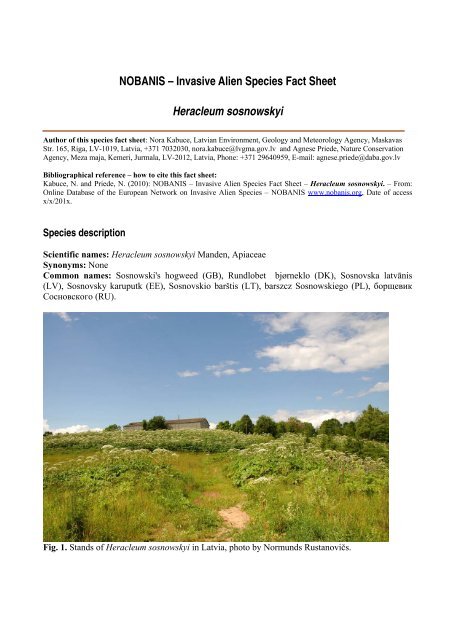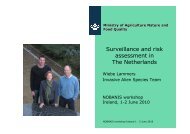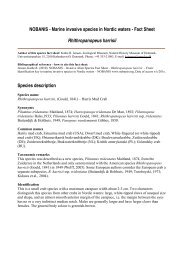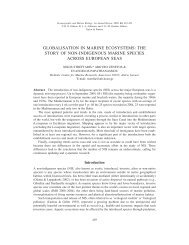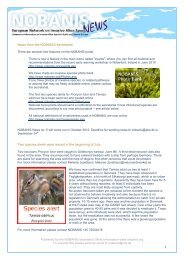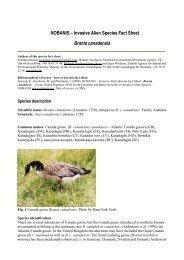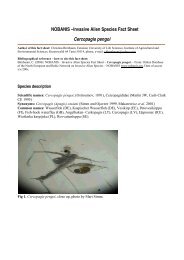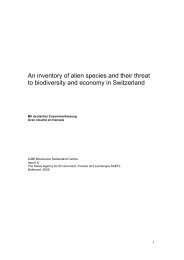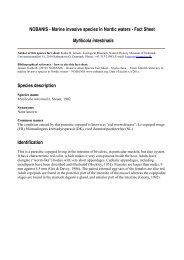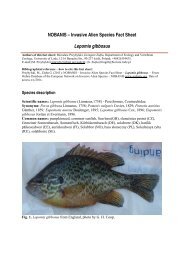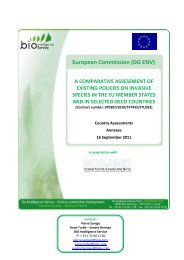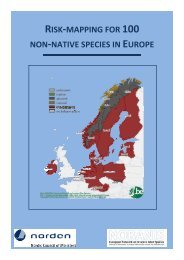NOBANIS – Invasive Alien Species Fact Sheet Heracleum sosnowskyi
NOBANIS – Invasive Alien Species Fact Sheet Heracleum sosnowskyi
NOBANIS – Invasive Alien Species Fact Sheet Heracleum sosnowskyi
Create successful ePaper yourself
Turn your PDF publications into a flip-book with our unique Google optimized e-Paper software.
<strong>NOBANIS</strong> <strong>–</strong> <strong>Invasive</strong> <strong>Alien</strong> <strong>Species</strong> <strong>Fact</strong> <strong>Sheet</strong><br />
<strong>Heracleum</strong> <strong>sosnowskyi</strong><br />
Author of this species fact sheet: Nora Kabuce, Latvian Environment, Geology and Meteorology Agency, Maskavas<br />
Str. 165, Riga, LV-1019, Latvia, +371 7032030, nora.kabuce@lvgma.gov.lv and Agnese Priede, Nature Conservation<br />
Agency, Meza maja, Kemeri, Jurmala, LV-2012, Latvia, Phone: +371 29640959, E-mail: agnese.priede@daba.gov.lv<br />
Bibliographical reference <strong>–</strong> how to cite this fact sheet:<br />
Kabuce, N. and Priede, N. (2010): <strong>NOBANIS</strong> <strong>–</strong> <strong>Invasive</strong> <strong>Alien</strong> <strong>Species</strong> <strong>Fact</strong> <strong>Sheet</strong> <strong>–</strong> <strong>Heracleum</strong> <strong>sosnowskyi</strong>. <strong>–</strong> From:<br />
Online Database of the European Network on <strong>Invasive</strong> <strong>Alien</strong> <strong>Species</strong> <strong>–</strong> <strong>NOBANIS</strong> www.nobanis.org, Date of access<br />
x/x/201x.<br />
<strong>Species</strong> description<br />
Scientific names: <strong>Heracleum</strong> <strong>sosnowskyi</strong> Manden, Apiaceae<br />
Synonyms: None<br />
Common names: Sosnowski's hogweed (GB), Rundlobet bjørneklo (DK), Sosnovska latvānis<br />
(LV), Sosnovsky karuputk (EE), Sosnovskio barštis (LT), barszcz Sosnowskiego (PL), борщевик<br />
Сосновского (RU).<br />
Fig. 1. Stands of <strong>Heracleum</strong> <strong>sosnowskyi</strong> in Latvia, photo by Normunds Rustanovičs.
Fig. 2. Stands of <strong>Heracleum</strong> <strong>sosnowskyi</strong> in Latvia, photo by Normunds Rustanovičs.<br />
Fig. 3 and 4. <strong>Heracleum</strong> <strong>sosnowskyi</strong> flowers and growth form, photos by Normunds Rustanovičs<br />
<strong>Species</strong> identification<br />
<strong>Heracleum</strong> <strong>sosnowskyi</strong> is biennial or perennial plant. Height is usually 100-300 cm. The stem is<br />
ridged and sparsely hairy with purple blotches. On the upper surface the leaves are hairless and<br />
below slightly hairy. Lower leaves divided into three segments that are non-deeply divided into oval<br />
shortly sharply pointed parts. The leaf margins have short rounded teeth. The flowers are white,<br />
sometimes pinkish. Outer petals radiate, 9-10 mm long. Slightly convex compound umbels, 30-50<br />
cm across. 30-75 rays with only short hairs. Flowering typically lasts from June to August. The fruits<br />
are egg-shaped or oval; 8-10 mm (<strong>–</strong>15 mm) long, when they are unripe they are densely hairy. Ripe<br />
2
fruit wings with numerous spines situated on small spherical or ovoid swellings. Fruits have very<br />
conspicuous oil ducts that do not reach the fruit base (Nielsen et al. 2005).<br />
Several botanists consider H. <strong>sosnowskyi</strong> only as the subtaxon of H. mantegazzianum or H.<br />
pubescens. Therefore, H. <strong>sosnowskyi</strong> does not appear in the lists of weedy flora of many West-<br />
European countries. H. <strong>sosnowskyi</strong> was described as a separate species by I. Mandenova in 1944<br />
(Lapiņš et al. 2002, Oboļeviča 2001).<br />
Native range<br />
<strong>Heracleum</strong> <strong>sosnowskyi</strong> originates in the central and eastern Caucasus and western, central, eastern<br />
and southwestern Transcaucasia and in northeastern Turkey (Gavrilova 2003, Jahodová et al. 2007a,<br />
2007b, Fig. 5).<br />
Fig. 5. Native ranges of three hogweed species (Jahodová et al. 2007a).<br />
<strong>Alien</strong> distribution<br />
History of introduction and geographical spread<br />
H. <strong>sosnowskyi</strong> was originally described in 1944. The plant is hardy and can thrive in a cold climate.<br />
It was promoted as a crop for northwest Russia, where it was first introduced in 1947. From the<br />
1940s onwards, it was introduced as a fodder plant to Latvia, Estonia, Lithuania, Belarus, Ukraine<br />
and the former German Democratic Republic (Nielsen et al. 2005).<br />
In Russia the first herbarium sample was collected in 1948 from Serpukhov region of Moscow<br />
district. Before the 1970s H. <strong>sosnowskyi</strong> was rare, but since 1970s it was recorded in many sites<br />
(Игнатов и др. 1990). Apart from crop reason (livestock fodder) it was cultivated in many botanical<br />
gardens and sometimes as ornamental plant in gardens (Бялт 1999; Григорьевская и др. 2004).<br />
3
In Poland H. <strong>sosnowskyi</strong> was introduced in the second half of the 20th century. In 1958 studies<br />
aimed at determining remedial properties of H. <strong>sosnowskyi</strong> began in the Garden of Therapeutic<br />
Plants of Medical Academy in Wrocław (Kosteczka-Mądalska 1962, Kosteczka-Mądalska and<br />
Bańkowski 1963). The study plots were established in areas characterized by high precipitation. In<br />
Southern Poland such study plots were laid out in Zakopane (Lutyńska 1980, Walusiak 2005) and in<br />
Nidzica (Podhale region) as well as in Grodziec Sląski of Cieszyńskie Foothills. The plant was<br />
cultivated as an ornamental due to its attractive appearance.<br />
In Latvia H. <strong>sosnowskyi</strong> was sown as a fodder (silage) plant for the first time in 1948, and was<br />
grown on experimental agricultural farms. In 1956 E. Eihe described it for the first time as a fodder<br />
plant (Gavrilova and Roze 2005) and in the 1960s cultivation for forage needs began (Laiviņš and<br />
Gavrilova 2003). In some regions in Latvia, the plant was cultivated as a honey plant and with the<br />
purpose to use its seeds as fowl forage, in many cases also as an ornamental.<br />
In Estonia the first report of H. <strong>sosnowskyi</strong> is from 1957, when it was introduced as a silage and<br />
honey plant, and the plantations were promoted up to the 1980s (M. Linnamägi, pers. comm.). In<br />
Lithuania the plant was introduced in the 1950s (Nielsen et al. 2005), though the first herbaria<br />
specimen was collected considerably later in 1987 (Gudžinskas 1998).<br />
Plantation schemes were eventually abandoned in the Baltic States, partly because the anise scented<br />
plants affected the flavour of meat and milk from the animals to which it was fed and partly because<br />
of the health risk to humans and cattle. In the Baltic States by the end of the 20 th century the plant<br />
was spread over considerable areas invading also natural habitats, therefore in the 1980s it was first<br />
considered as somewhat noxious weed. In 1986 in Latvia (Rasiņš 1986) and 1987 in Estonia it was<br />
first time defined as an aggressive weed.<br />
H. <strong>sosnowskyi</strong> is present also in Germany (Nielsen et al. 2002, Jahodová et al. 2007b, Lambdon et<br />
al. 2008) and Hungary (Lambdon et al. 2008), though occurring only in few sites. In the Nordic<br />
countries the species is known only from Denmark (Fröberg 2009).<br />
Pathways of introduction<br />
H. <strong>sosnowskyi</strong> was introduced as an agricultural crop to Europe where its large biomass was<br />
ensilaged to provide fodder for livestock (Nielsen et al. 2005).<br />
<strong>Alien</strong> status in region<br />
The alien range of H. <strong>sosnowskyi</strong> covers the Baltic States, European part of Russia, Belarus and<br />
Ukraine, sporadically occurring in Poland, Hungary, Germany and Denmark. However, detailed<br />
distribution data could not be located (Nielsen et al. 2005). It has been naturalized in many regions<br />
of European Russia from Murmansk to Lipetzk and Voronezh (Флора Восточной Европы 2004)<br />
(Fig. 6 and 7).<br />
4
Fig. 6. Distribution of <strong>Heracleum</strong> <strong>sosnowskyi</strong> in Europe (Jahodová et al. 2007a). In the shaded<br />
countries the species is present, but the exact distribution is not known.<br />
Fig. 7. Map of samples of <strong>Heracleum</strong> <strong>sosnowskyi</strong> collected in Europe (Jahodová et al. 2007b).<br />
Map of the sampled populations: <strong>Heracleum</strong> mantegazzianum; <strong>Heracleum</strong> persicum;<br />
<strong>Heracleum</strong> <strong>sosnowskyi</strong>; other <strong>Heracleum</strong> species; outgroup species.<br />
Currently, H. <strong>sosnowskyi</strong> in the Baltic States, especially in Latvia, has spread forming stands of<br />
hundreds and thousands of square meters and being widespread across all three countries (Fig. 8, 9,<br />
5
10, Table 1). For example, the total area invaded by H. <strong>sosnowskyi</strong> in Latvia is 12 225 ha (estimated<br />
in 2001) (Bērziņš et al. 2003). According to the latest measurements, at the end of 2010 the invaded<br />
registered areas in Latvia comprised 10 230 ha (Anonymous 2010) which most probably not include<br />
more than 2/3 of the actual total invaded area. According to Bērziņš et al. (2003), invaded areas in<br />
Latvia increase every year by ca. 10%.<br />
In Estonia in 2010 more then 1 300 ha were covered with over 1 000 known H. <strong>sosnowskyi</strong> colonies,<br />
and there are still probably unknown colonies (M. Linnamägi, pers.com.).<br />
Fig. 8. Distribution of <strong>Heracleum</strong> <strong>sosnowskyi</strong> in<br />
Estonia (Kukk and Kull 2005).<br />
Fig. 9. Distribution of <strong>Heracleum</strong><br />
<strong>sosnowskyi</strong> in Estonia (Gudžinskas, unpubl.).<br />
Fig. 10. Distribution of <strong>Heracleum</strong> <strong>sosnowskyi</strong> in Latvia (Gavrilova 2003).<br />
In Iceland, H. <strong>sosnowskyi</strong> may or may not have escaped from cultivation. It was cultivated in the<br />
Reykjavik Botanic Garden for 12 years. Since the plants were spreading outside the planting, they<br />
were eradicated (D. Jakobsdottir, pers. comm.).<br />
6
Country Not Not Rare Local Common Very Not<br />
found established<br />
common known<br />
Austria X<br />
Belgium X<br />
Czech Republic X<br />
Denmark X<br />
Estonia X<br />
European part of Russia X<br />
Finland X<br />
Faroe Islands X<br />
Germany X<br />
Greenland X<br />
Iceland X<br />
Ireland X<br />
Latvia X<br />
Lithuania X<br />
Netherlands X<br />
Norway X<br />
Poland X<br />
Slovakia X<br />
Sweden X<br />
Table 1. The frequency and establishment of <strong>Heracleum</strong> <strong>sosnowskyi</strong>, please refer also to the<br />
information provided for this species at www.nobanis.org/search.asp. Legend for this table: Not<br />
found <strong>–</strong>The species is not found in the country; Not established - The species has not formed selfreproducing<br />
populations (but is found as a casual or incidental species); Rare - Few sites where it is<br />
found in the country; Local - Locally abundant, many individuals in some areas of the country;<br />
Common - Many sites in the country; Very common - Many sites and many individuals; Not<br />
known <strong>–</strong> No information was available.<br />
Ecology<br />
Habitat description<br />
The species is mostly found in human-created habitats (roadsides, disturbed habitats, agricultural<br />
fields, abandoned farm yards and gardens) and semi-natural habitats (shrublands, grasslands, parks,<br />
pastures, abandoned orchards) (Gavrilova 2003).<br />
H. <strong>sosnowskyi</strong> has invaded riverbanks and adjacent floodlands, and in many cases also secondary or<br />
disturbed forests. Nowadays, the naturalization of H. <strong>sosnowskyi</strong> is out of control, and the plant has<br />
spread almost all over the Baltic States, mainly on abandoned agricultural lands often migrating<br />
down the streams (Oboļeviča 2001).<br />
In natural habitats H. <strong>sosnowskyi</strong> develops large stands, e.g. in meadows, river valleys and forest<br />
fringes as well as on flood-plains of rivers and lakes. Hogweeds form dense stands vigorously<br />
invading and overwhelming the native plant communities. The newly emerged neophyte community<br />
is often nearly monodominant and poor in species (Laiviņš and Gavrilova 2003).<br />
7
Reproduction and life cycle<br />
There are differing opinions about the life span of this species in Latvia. One opinion is that it is a<br />
biennial plant - in the first year it forms a large rosette and strong root system, in the second - great<br />
size and inflorescence with a considerable number of seeds. After fruiting the plant dies. Another<br />
opinion is that H. <strong>sosnowskyi</strong> is a perennial plant. Evidence supporting this opinion is the different<br />
rate of seed germination in the period of post-maturation, which can last 2 - 4 years. Another support<br />
for this view is the competition between the hogweeds in which some plants are not able to produce<br />
inflorescence 2 - 5 years after another. Therefore, seed production and life span lasts between 3 - 6<br />
years, sometimes even longer.<br />
Studies have been carried out in which the seedset was excluded by mowing before the inflorescence<br />
was formed. The results showed that in the second and following years the species was able to<br />
survive the winter and produce seeds and then die after flowering.<br />
Many practical workers consider that even when the mother plant dies, the off-root buds are able to<br />
produce shoots giving rise to new plants and in such a way become perennial plants. The new shoots<br />
of H. <strong>sosnowskyi</strong> are rather cold resistant and can survive -4 to -7 °C. It is found that starting from<br />
the second year they can survive down to -25 °C and under a snow cover even down to -45 °C. H.<br />
<strong>sosnowskyi</strong> is a light demanding plant and at the beginning of their growth they do not survive in<br />
shade (Oboļeviča 2001).<br />
Dispersal and spread<br />
Several main modes of seed dispersal are known, some are natural and some are human assisted. The<br />
description of seed dispersal is based on studies on H. mantegazzianum but the same of them applies<br />
to H. <strong>sosnowskyi</strong>. Populations often occur along streams and then water can spread seeds very<br />
efficiently, in large numbers and over considerable distances. Long-distance dispersal events that<br />
transport the seeds far from the source population are important mechanisms of plant dispersal, e.g.<br />
during extreme events such as floods. Wind is an important vector of local dispersal, especially in<br />
winter when seeds are blown over the frozen or snow-covered soil surface.<br />
H. <strong>sosnowskyi</strong> is also spread by various human activities. Roadside ditches and margins are among<br />
the most typical habitats and seeds may stick to tires of passing cars and can be spread far from the<br />
place where they were produced. Other mechanisms of seed dispersal by human activities are<br />
translocation of seeds with soil or dispersal of seeds attached to clothes or animal fur, e.g. sheep and<br />
cattle. If suitable sites are available, a high rate of spread is possible on both local and regional scales<br />
(Nielsen et al. 2005, Laiviņš and Gavrilova 2003). H. <strong>sosnowskyi</strong> is used as a decoration when dry<br />
which also perhaps contribute to the human-assisted dispersal of seeds.<br />
Impact<br />
Affected habitats and indigenous organisms<br />
H. <strong>sosnowskyi</strong> stands may range in extent from square metres to hectares, and small patches, linear<br />
stands or fringes can be found, e.g. along a streams, or scattered individuals. Even narrow stands<br />
may be conspicuous owing to the large stature of the species. The density of populations of hogweed<br />
may also vary considerably. In large stands, density may range from sparse growth (1-3 adult<br />
individuals/10 m 2 ) to covering almost the entire ground area (more than 20 adult individuals/10 m 2 )<br />
(Nielsen et al. 2005).<br />
8
Over the last 20 years H. <strong>sosnowskyi</strong> communities have spread intensively in Latvia mostly in<br />
human-created and semi-natural habitats (Laiviņš and Gavrilova 2003). The enormous height and<br />
leaf area of H. <strong>sosnowskyi</strong>, extraordinary for herbaceous species, enable them domination over most<br />
of indigenous plant species and hence make them strong competitors for light. In dominant stands,<br />
up to 80% of the incoming light is absorbed by hogweed, thus suppressing other light demanding<br />
species (Nielsen et al. 2005). When the hogweeds have taken root they thus form their own<br />
community (Oboļeviča 2001). H. <strong>sosnowskyi</strong> often reaches high densities in abandoned grasslands<br />
and ruderal habitats, leading to a strong decline in the species richness of the invaded habitats<br />
(Nielsen et al. 2005).<br />
Genetic effects<br />
<strong>Species</strong> of the genus <strong>Heracleum</strong> can hybridize causing confusing in species identification (Gavrilova<br />
2003; Anonymous 2009). Hybridisation with the native <strong>Heracleum</strong> sibiricum and H. spondyllium<br />
and other introduced hogweeds are possible (Z. Gudžinskas, pers. comm.).<br />
Human health effects<br />
H. <strong>sosnowskyi</strong> represents a serious health hazard for humans. The plant exudes a clear watery sap,<br />
which contains several chemicals that are activated in sunlight known as photosensitising<br />
furanocoumarins (synonym for furocoumarins). In contact with the human skin and in combination<br />
with ultraviolet radiation, these chemicals cause burnings of the skin. The content of<br />
furanocoumarins varies among plant parts; however, during the season skin contact should be<br />
avoided at any time even in the absence of sunlight (specifically ultraviolet radiation). The<br />
phototoxic reaction can be activated by ultraviolet radiation only 15 minutes after contact, with a<br />
sensitivity peak between 30 min and two hours. In addition, several furanocoumarins have been<br />
reported to be carcinogenic (i.e. they cause cancer) and teratogenic (i.e. they cause malformations in<br />
the growing embryo).<br />
After a period of about 24 hours, flushing or reddening of the skin (erythema) and excessive<br />
accumulation of fluid in the skin (oedema) appear, followed by an inflammatory reaction after three<br />
days. The reaction of the skin will also depend on individual sensitivity. Approximately one week<br />
later, hyperpigmentation (unusual darkening of the skin) occurs on the affected areas, which can last<br />
for months. The affected skin may remain sensitive to ultraviolet light for years. Moisture, e.g.<br />
sweating or dew, and heat enhance the skin reaction (Nielsen et al. 2005).<br />
Economic and societal effects (positive/negative)<br />
In the former Soviet Union H. <strong>sosnowskyi</strong> was cultivated in experimental farms as a prospective<br />
forage (silage) crop and honey plant. In parts of northern Russia, cultivation of the plant is still<br />
continued (Nielsen et al. 2005). In Estonia there are still bee keepers who believe it is a good honey<br />
plant and refuse to let eradicators on their land (M. Linnamägi, pers. com.).<br />
Today majority of the escaped H. <strong>sosnowskyi</strong> populations are out of human control throughout the<br />
east Baltic region. There are several methods to control H. <strong>sosnowskyi</strong>, but all of them require<br />
resources (Nielsen et al. 2005). In open areas the hogweed control is mostly an economic and<br />
agriculture organizing problem, than a technological one. The elimination of the species is more<br />
complicated on shores, in ditches and on roadsides, where the use of herbicides is restricted or not<br />
allowed (Oboļeviča 2001). The cost of controlling all invasive hogweeds varies considerably<br />
depending on the control method used (Nielsen et al. 2005).<br />
9
Management approaches<br />
Prevention methods<br />
H. <strong>sosnowskyi</strong> is included in the lists of the most aggressive alien species in all Baltic States<br />
(Gavrilova 2003). It is also included in the European and Mediterranean Plant Protection<br />
Organization (EPPO) list of invasive alien plants.<br />
It is necessary to raise public awareness on the rapid spread of this species and at the same time<br />
motivate land managers by providing control methods, work safety regulations and financial support.<br />
It is particularly important to eradicate the established populations from river banks to restrict the<br />
rapid spread into natural riparian habitats.<br />
In Estonia and Latvia H. <strong>sosnowskyi</strong> is listed as invasive species and systems for its control and<br />
monitoring are established. Cultivating, importing and selling of this species in both countries are<br />
prohibited by law.<br />
In Estonia the species is listed as non-native invasive species in the Estonian Nature Conservation<br />
Act (2004) followed by action strategy and eradication guidelines including preliminary mapping of<br />
species distribution all over the country (M. Linnamägi, pers. com.). In Latvia the National Program<br />
of Hogweed Control (2006-2012) aimed at controlling and eradication of H. <strong>sosnowskyi</strong> was<br />
approved in 2005. The program proposes establishment of a coordinated hogweed control system<br />
including the responsibilities and administration of financial resources. In 2008 in Latvia two<br />
regulations regarding H. <strong>sosnowskyi</strong> were issued defining its invasivity, the responsible national<br />
executives, eradication methods, information and monitoring.<br />
Eradication, control and monitoring efforts<br />
Currently used control methods comprise a variety of manual and mechanical methods, grazing and<br />
herbicide application (Table 2). Rather than recommending a single control method, a control<br />
program based on an Integrated Weed Management Strategy is preferred. The selection of control<br />
methods depends on the area covered by the plant, plant density and accessibility of the stand.<br />
Regardless of the control method, the management usually requires repeated and correct application<br />
in order to obtain satisfactory control. Accordingly, to make the most of the control efforts, the<br />
treatment of plants should be started early in the growing season and continue for several years until<br />
the soil seed bank is depleted and the root system has died. The cost of controlling tall invasive<br />
hogweeds varies considerably depending on the control method used. Differences in availability of<br />
equipment and price of labour will influence ‘best choice’ (Nielsen et al. 2005).<br />
Afforestation is a special case of cover crop strategy that could be applied against such weeds as tall<br />
invasive hogweeds. There is variation among the different tall invasive hogweed species with respect<br />
to shade tolerance: H. mantegazzianum is less shade tolerant than H. <strong>sosnowskyi</strong> (Nielsen et al.<br />
2005).<br />
10
Population size<br />
Few plants, 5-100<br />
individuals<br />
Small colony, 100-<br />
1000 plants<br />
Large colony,<br />
>1000 plants<br />
Control options<br />
Estimated time effort<br />
Root cutting 100 plants/hour<br />
(plants in their second growing<br />
season)<br />
Mechanical cutting 100-200 plants in less than one<br />
Notes<br />
Labour expensive, but an<br />
effective and efficient method<br />
hour when using a scythe<br />
Less labour expensive than<br />
root cutting, but less effective<br />
Chemical control, spot 100-200 plants/hour Needs to comply with national<br />
treatment<br />
rules and guidelines for<br />
herbicide use<br />
Root cutting 100 plants/hour<br />
Labour expensive, but<br />
(plants in their second growing<br />
season)<br />
efficient<br />
Mechanical mowing or<br />
cutting<br />
Mechanical mowing by flail<br />
mower: 0.25-1 ha/hour<br />
Mechanical cutting by scythe:<br />
High density: 1500 plants/hour<br />
Medium density: 1,000<br />
plants/hour<br />
Low density: 500 plants/hour<br />
Machinery is required<br />
Chemical control 300 m 2 /hour Hand-held equipment<br />
Grazing (see below for scale of effort) Should be considered if<br />
Ploughing, milling or<br />
mechanical mowing<br />
Mechanical mowing by flail<br />
mower: 0.25-1 ha/hour<br />
neighbouring areas are grazed<br />
Machinery is required. Not all<br />
stands are accessible for heavy<br />
machinery<br />
Chemical control 0.5-1 ha/hour Machinery is required<br />
Grazing<br />
1000 hours per year for daily Total cost depends on the price<br />
inspection and moving of 170 of fencing, maintenance and<br />
sheep distributed on 10 different<br />
areas<br />
inspection of the animals<br />
Table 2. Recommended control options (Nielsen et al. 2005).<br />
In Estonia the mapping of H. <strong>sosnowskyi</strong> colonies started in 2003 and was continued in the following<br />
years. Eradication works in Estonia started in 2005 as a small scale testing year and have continued<br />
ever since with enlarging of the eradication area annually. Area with eradicated colonies in the<br />
following years was 235 ha in 2005, 605 ha in 2006, 609 ha in 2007, 886 ha in 2008, 861 ha in 2009<br />
and 1 210 ha in 2010 with about 435 000 EUR eradication budget. Since 2006, the eradication work<br />
has been done all over Estonia (M. Linnamägi, pers.com.).<br />
In Latvia up to 2007 the distribution data and areas invaded by H. <strong>sosnowskyi</strong> were based on<br />
botanical records (e.g. Laiviņš and Gavrilova 2003, Priede 2008) and approximate estimations by<br />
local municipalities (Oboļeviča 2001). In 2007, the Latvian State Plant Protection Service began<br />
mapping of invaded areas allowing to estimate the actual distribution, rate of spreading and to<br />
monitor the eradication efforts (A. Garkāje, pers. comm.). In Latvia the eradication actions are<br />
ongoing throughout the country, though impeded by lack of continuous financial support and<br />
therefore being rather local, than nationwide.<br />
In Estonia numerous problems appeared in practical eradication actions, e.g. eradication of<br />
<strong>Heracleum</strong> in rocky riversides (cannot use herbicides, manual removal nearly impossible), closed<br />
territories, border areas (inaccessible or successful eradication on the Estonian side is followed by<br />
11
cross-border species immigration of new colonies) and eco-farms (use of herbicides is not allowed,<br />
while the invaded areas are too large for manual digging) (M. Linnamägi, pers.com.).<br />
Information and awareness<br />
Only during the last few years the community has been informed about the negative impacts caused<br />
by H. <strong>sosnowskyi</strong>. Over the last decade, there have been numerous publications in press, information<br />
given on television and about this problem in the Baltic States. Documentary films on the best<br />
control methods and human health effects of H. <strong>sosnowskyi</strong> have been produced in Lithuania and<br />
Estonia. In the Baltic States over the last years there have been a growing number of publications on<br />
hogweed in brochures, information in media and on the internet (see Links below).<br />
Knowledge and research<br />
The Giant <strong>Alien</strong> Project (2002-2005), an EU research program, had as its main objective to develop<br />
an integrated management strategy that comprises effective, practicable and sustainable means of<br />
controlling an alien non-agricultural weed (H. mantegazzianum). One of the results was “The Giant<br />
Hogweed Best Practice Manual”, which includes descriptions and keys of invasive Hercleum species<br />
in Europe, gives guidelines for the management and control of H. sosnowkyi in Europe, provides<br />
examples of successful control of the plant by soil cultivation, chemical control and revegetation.<br />
The recommendations are especially suitable for former agricultural land that has not been cultivated<br />
for several years and other areas set aside from agriculture with heavy infestations of H. <strong>sosnowskyi</strong><br />
(Nielsen et al. 2005).<br />
Numerous studies on different aspects of <strong>Heracleum</strong> species in their invaded range in Europe were<br />
published in the Ecology & Management of Giant Hogweed (<strong>Heracleum</strong> mantegazzianum) by Pyšek<br />
et al. (2007).<br />
In Latvia, studies on the species morphology, distribution and control methods were conducted at the<br />
Institute of Biology (Gavrilova 2003, Laiviņš and Gavrilova 2003), Latvian University of<br />
Agriculture (Bērziņš et al. 2003) and Latvian State Plant Protection Service. Since 2006, the<br />
administration of the nature-protected area North Vidzeme Biosphere Reserve organizes a public<br />
monitoring involving the local population in gathering the data on the distribution of H. <strong>sosnowskyi</strong>.<br />
Furthermore, investigations on plant communities with H. <strong>sosnowskyi</strong> were performed in 2002 <strong>–</strong><br />
2004 all over Lithuania (Gudžinskas and Rašomavičius 2005) and in 2002-2003 in Estonia (Holm<br />
2005).<br />
The history of invasion and actual status of H. <strong>sosnowskyi</strong> and H. mantegazzianum has been<br />
investigated in the area of the Sub Tatra Trough by Edward Walusiak (Walusiak 2005).<br />
Recommendations or comments from experts and local communities<br />
See Giant <strong>Alien</strong> Project (Nielsen et al. 2005), Pyšek et al. (2007) and EPPO Bulletin.<br />
References and other resources<br />
Contact persons<br />
Hans Peter Ravn (DK), Forest & Landscape Denmark, University of Copenhagen, Hoersholm<br />
Kongevej 11, DK-2970 Hoersholm, Denmark, E-mail: hpr@life.ku.dk<br />
Bert Holm (EE), Institute of Agricultural and Environmental Sciences, Estonian University of Life<br />
Sciences, Riia 181, 51014 Tartu, Estonia, E-mail: Bert@zbi.ee<br />
12
Arto Kurtto (FI) Finnish Museum of Natural History, Botanical Museum, P.O.Box 7, FIN-00014<br />
University of Helsinki, Phone: +358-9-191 8630, E-mail: arto.kurtto@helsinki.fi<br />
Dora Jakobsdottir (IS), curator, Reykjavik Botanic Garden, Laugardalur, IS-104 Reykjavik, E-mail:<br />
dora.jakobsdottir@reykjavik.is<br />
Zigmantas Gudžinskas (LT), Institute of Botany, Žaliųjų Ežerų Str. 49, LT-08406 Vilnius, Lithuania,<br />
E-mail: zigmantas.g@botanika.lt<br />
Ģertrūde Gavrilova (LV), Institute of Biology, University of Latvia, Miera 3, Salaspils, LV-2169,<br />
Latvia, E-mail: gga@email.lubi.edu.lv<br />
Svein Båtvik (NO) Directorate for Nature Management Tungasletta 2. NO-7485 Trondheim, Phone:<br />
+73 58 05 00, E-mail: Svein-T.Batvik@dirnar.no<br />
Edward Walusiak (PL), Institute of Nature Conservation Polish Academy of Sciences, Department<br />
of Flora Conservation, Mickiewicza 33, PL-31-120 Kraków, Poland, E-mail:<br />
walusiak@iop.krakow.pl<br />
Olga Morozova (RU), Institute of Geography Russian Academy of Sciences, Laboratory of<br />
Biogeography, Staromonetny, 29, Moscow, 119017, Russia, E-mail: biogeo@igras.geonet.ru<br />
Melanie Josefsson (SE) Swedish Environmental Protection Agency, c/o Dept. of Environmental<br />
Analysis, P.O. Box 7050, SE 750 07 Uppsala. Phone: +46 18 67 31 48 Fax: +46 18 67 31 56, Email:<br />
Melanie.Josefsson@snv.slu.se<br />
Links<br />
Giant <strong>Alien</strong> Project (in eight languages)<br />
<strong>Heracleum</strong> mantegazzianum, H. <strong>sosnowskyi</strong> and H. persicum (EPPO Bulletin)<br />
Distribution of H. <strong>sosnowskyi</strong>, its control and limitation in Latvia (in Latvian)<br />
Sites invaded by <strong>Heracleum</strong> sosnowsky in Estonia (photo gallery)<br />
Information leaflet (in Estonian)<br />
Information leaflet (in Estonian)<br />
Documentary film (in Estonian and Russian, 2 links at the bottom of the page)<br />
References<br />
Anonymous 2009. <strong>Heracleum</strong> mantegazzianum, <strong>Heracleum</strong> <strong>sosnowskyi</strong> and <strong>Heracleum</strong> persicum. OEPP/EPPO Bulletin<br />
39: 4889-499.<br />
Anonymous 2010. Paveiktais Sosnovska latvāņa izplatības ierobežošanā. http://www.vaad.gov.lv/sakums/informacijasabiedribai/par-latviju-bez-latvaniem/paveiktais-sosnovska-latvana-izplatibas-ierobezosana.aspx<br />
Bērziņš A., Oļukalns A., Lapiņš D., Lejiņš A., Sprincina A., Gavrilova Ģ. and Liguts V. 2003. Latvānis (<strong>Heracleum</strong>) un<br />
tā izplatība Latvijā [Distribution of hogweed (<strong>Heracleum</strong>) in Latvia]. - Agronomijas Vēstis, LLMZA, Nr.5, 86 <strong>–</strong> 93.<br />
Fröberg L. 2009. <strong>Heracleum</strong>. Flora Nordica. http://www.floranordica.org/Review/-<br />
Review_public/accounts/<strong>Heracleum</strong>.html<br />
Gavrilova Ģ. 2003. Report on investigation of <strong>Heracleum</strong> in Latvia in 2003. - Institute of Biology.<br />
Gavrilova Ģ. and Roze I. 2005. <strong>Species</strong> of genus <strong>Heracleum</strong> L. and their distribution in Latvia. - 3 rd International<br />
conference “Research and conservation of biological diversity in Baltic region”, Book of abstract. Daugavpils<br />
University, Daugavpils, Latvia; 20 <strong>–</strong> 22 April, 56.<br />
13
Gudžinskas Z., 1998. Conspectus of alien plant species of Lithuania. 7. Apiaceae, Apocynaceae, Asclepiadaceae,<br />
Caprifoliaceae, Dipsacaceae, Oleaceae,Sambucaceae, Viburnaceae, and Valerianaceae. - Botanica Lithuanica, 4(3):<br />
249-265.<br />
Gudžinskas Z. and Rašomavičius V. 2005. Communities and habitat preferences of <strong>Heracleum</strong> <strong>sosnowskyi</strong> in Lithuania.<br />
In: The Ecology and Management of the Giant <strong>Alien</strong> <strong>Heracleum</strong> mantegazzianum. Final International Workshop of<br />
the ‘Giant <strong>Alien</strong>’ Project. Justus<strong>–</strong>Liebig <strong>–</strong> University Giessen. Division of Landscape Ecology and Landscape<br />
Planning. Germany, 21.<br />
Holm, B. 2005. Biology, distribution and control of invasive alien <strong>Heracleum</strong> species. Master thesis. Estonian<br />
Agricultural University.<br />
Jahodová Š., Fröberg L., Pyšek P., Geltman D., Trybush S. and Karp A. 2007a. Taxonomy, identification, genetic<br />
relationships and distribution of large <strong>Heracleum</strong> species in Europe. In Ecology and Management of Giant Hogweed<br />
(<strong>Heracleum</strong> mantegazzianum) (ed. Pyšek P., Cock M. J. W., Nentwig W. and Ravn H. P.) CAB International,<br />
Wallingford, UK, pp. 1-19.<br />
Jahodová Š., Trybush S., Pyšek P., Wade M. and Karp A. 2007b. <strong>Invasive</strong> species of <strong>Heracleum</strong> in Europe: an insight<br />
into genetic relationships and invasion history. Diversity and Distributions 13: 99-114.<br />
Kostecka-Mądalska O. 1962. <strong>Heracleum</strong> <strong>sosnowskyi</strong> MANDEN. w Ogrodzie Roślin Leczniczych A.M. we Wrocławiu. -<br />
Wiadomości Botaniczne IV, 2: 175-177.<br />
Kostecka-Mądalska O. and Bańkowski C. 1963. Zawartość olejku eterycznego w <strong>Heracleum</strong> Sosnowskyi Manden. z<br />
uprawy krajowej. - Acta Agrobotanica XIV: 25-31.<br />
Kukk, T. and Kull, T. 2005. Atlas of the Estonian Flora. p 44<br />
Laiviņš M. and Gavrilova Ģ. 2003. Neofītās Sosnovska latvāņa <strong>Heracleum</strong> <strong>sosnowskyi</strong> sabiedrības Latvijā [<strong>Heracleum</strong><br />
<strong>sosnowskyi</strong> in Latvia: sociology, ecology and distribution]. - Latvijas Veģetācija 7: 45 - 65.<br />
Lambdon, P.W., Pyšek, P., Basnou, C., Hejda, M., Arianoutsou, M., Essl, F., Jarošík, V., Pergl, J. Winter, M.,<br />
Anastasiu, P., Andriopoulos, P., Bazos, I., Brundu, G., Grapow-Celesti, L., Delipetrou, P., Josefsson, M., Kark, S.,<br />
Klotz, S., Kokkoris, Y., Kühn, I., Merchante, H., Perglova, I., Pino, J., Monserrat, V., Zios, A., Roy, D., Hulme,<br />
P.E. (2008) <strong>Alien</strong> flora of Europe: species diversity, temporal trends, geographical patterns and research needs.<br />
Preslia 80: 101-149.<br />
Lapiņš D., Bērziņš A., Gavrilova Ģ., Riekstiņš A., Karpenskis G., Narvils M., Runce A., Liguts V. and Stašinskis R.<br />
2002. Latvāņi, to izplatības ierobežošana / Pagaidu rekomendācijas [Hogweed, bringing their spread under control /<br />
Provisional recommendations]. <strong>–</strong> Ozolnieki, LLKC, 28 pp.<br />
Lutyńska R. 1980. Studies on the acclimatization of <strong>Heracleum</strong> <strong>sosnowskyi</strong> Manden and its use as a fodder plant. -<br />
Biuletyn Instytutu Hodowli I Aklimatyzacji Roślin 139: 3-36.<br />
Nielsen, C., Ravn, H.P. , Nentwig, W. and Wade, M. (eds.) 2005. The Giant Hogweed Best Practice Manual. Guidelines<br />
for the management and control of an invasive weed in Europe. - Forest and Landscape Denmark, Hoersholm, 44 pp.<br />
Oboļeviča D. 2001. Latvānis un tā izplatība Latvijā [Hogweed and its distribution in Latvia].<br />
Pyšek P. Cock M.J.W., Nentwig W. And Ravn H.P. (eds.) 2007. Ecology & management of giant hogweed (<strong>Heracleum</strong><br />
mantegazzianum). - CAB International, Wallingford, UK.<br />
Priede, A. 2008. Invazīvo neofītu sugu izplatība Latvijā [Distribution of invasive neophytes in Latvia]. - Latvijas<br />
Veģetācija 17: 1-148.<br />
Rasiņš, A., Fatare, I. (1986) Sosnovska latvānis - <strong>Heracleum</strong> <strong>sosnowskyi</strong> Manden. - bīstama nezāle Latvijas florā.<br />
Grām.: Retie augi un dzīvnieki. Rīga, 8.-10. lpp.<br />
Walusiak E. 2005. <strong>Heracleum</strong> <strong>sosnowskyi</strong> Manden and <strong>Heracleum</strong> mantegazzianum Sommier and Levier in the area of<br />
Sub Tatra Trough (Southern Poland). - 8th International Conference on the Ecology and Management of <strong>Alien</strong> Plants<br />
Invasions, University of Silesia, Katowice. Abstracts book.<br />
Бялт В.В. 1999. Редкие и новые заносные растения для Мурманской области. Ботанический журнал 84(5): 140-<br />
142.<br />
Григорьевская А.Я., Стародубцева Е.А., Хлызова Н.Ю., Агафонов В.А. 2004. Адвентивная флора Воронежской<br />
области: исторический, биогеографический, экологический аспекты. Изд-во ВГУ, Воронеж. 320 pp.<br />
Игнатов М.С., Макаров В.В., Чичев А.В. 1990. Конспект флоры адвентивных растений Московской области. В<br />
сб.: Флористические исследования в Московской области. M. Наука. pp. 5-105.<br />
Сацыперова И.Ф. 1984. Борщевики Флоры СССР <strong>–</strong> новые кормовые растения. <strong>–</strong> Ленинград, 223 pp.<br />
Date of creation/modification of this species fact sheet: 25-04-2007 / 07-12-2010<br />
14


